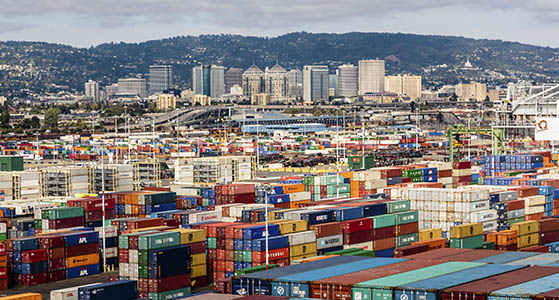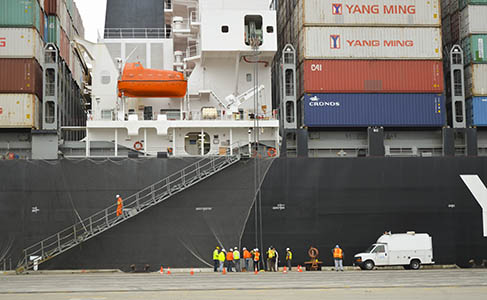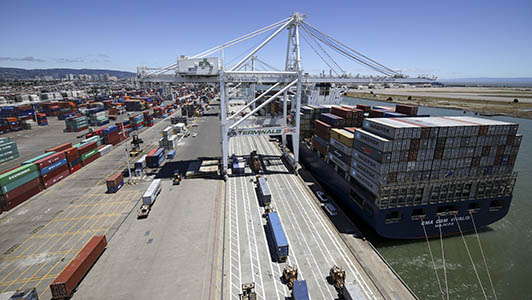Lost among the flurry of year-end wrap-ups and 2015 prediction pieces that dominated the news in December was an announcement by Lawrence Berkeley National Laboratory scientists that “drastic reductions” in diesel emissions had been measured at the Port of Oakland.

In December scientists at Lawrence Berkeley National Laboratory announced that drastic reductions in diesel emissions had been measured at the Port of Oakland. The independent study was funded by the Bay Area Air Quality Management District and the California Air Resources Board. Photo courtesy Port of Oakland
By Bill Picture
Published: February, 2015
Lost among the flurry of year-end wrap-ups and 2015 prediction pieces that dominated the news in December was an announcement by Lawrence Berkeley National Laboratory scientists that “drastic reductions” in diesel emissions had been measured at the Port of Oakland. The drop was big enough, in fact, to prompt the scientists to predict that persons most susceptible to port-generated air pollution—that is, port workers and nearby residents and business owners—can expect to breathe in cleaner air with their sighs of relief.
“We measured reductions of nitrogen oxides and black carbon particulate matter, which should translate into local improvements in air quality,” said Dr. Thomas Kirchstetter, one of the Berkeley scientists who conducted the study.
The study was an independent one—that is, not commissioned by the Port of Oakland, which conducts its own periodic assessments. The Berkeley lab’s study was funded by the Bay Area Air Quality Management District and the California Air Resources Board. These agencies, like the scientists, were curious how air quality at the Port of Oakland is being affected by the Clean Truck Program implemented in 2009.
That program set stringent new emissions standards for all trucks servicing the Port of Oakland, and required that truck owners take whatever measures were necessary to bring their vehicles into compliance. In some cases, that has meant retiring older vehicles and replacing them with newer, cleaner-burning trucks.
For the current study, Kirchstetter and his fellow Berkeley scientists took samples of the air along a busy truck corridor at the port over a five-year period—from 2009 to 2013. That period closely mirrored the implementation of the Clean Truck Program.
“The fact that it’s an independent, third-party verification is particularly gratifying because it confirms that we’re on the right track,” said Richard Sinkoff, director of environmental programs and planning at the Port of Oakland.
“What we do at the port is an analytical modeling exercise. We are running a scientific analysis based upon emission reduction factors. What the Berkeley Labs scientists did was go out into the field and take real-time measurements. They actually tested the air, so these results are really exciting.”
Coming up for air
The impact of port truck traffic on air quality has been of concern for some time to area residents. Ask anyone in West Oakland and they’ll tell you that the air in the neighborhood stinks—literally. But how much of the blame falls on the shoulders of the port depends on whom you ask.
A study commissioned in 2009 by state and local air quality officials showed that only 16 percent of the contributing pollutants came from port-related sources, including 4 percent that came specifically from port-servicing trucks. According to that study, the remaining 84 percent came from other sources, including vehicles on the nearby MacArthur Maze.
Some found those numbers hard to believe, insisting logic would dictate that the black smoke pouring from those thousands of trucks whizzing through the neighborhood on their way to and from the port would have to contribute more than 4 percent to the area’s poor air quality. Notwithstanding the results of the study, however, the Port of Oakland took the initiative to formulate a plan to clean up its act.
The result was the Maritime Air Quality Improvement Plan and an aggressive goal of reducing port diesel emissions by 85 percent from 2005 levels by 2020. The first step toward achieving that goal was the Clean Truck Program. The Berkeley scientists who conducted the air-quality study say that not only is the program working, it’s working fast.
“‘Accelerated’ is an understatement,” said Dr. Robert Harley, another member of the team that conducted the research, and a professor of civil and environmental engineering at UC Berkeley. “It would normally take decades to see this kind of change, not just a few years.”
Shore Power Program
Meanwhile, the Port of Oakland has also been keeping an eye on air quality in and around the port. A port-conducted review of data from 2012 showed that the port had already reduced diesel emissions by 70 percent, putting it well on its way to achieving its 2020 goal despite an increase in the amount of cargo being handled.
“And that 2012 data didn’t yet take into account the benefits that we project will come from full implementation and operation of the Shore Power Program,” said Sinkoff.
The Shore Power Program is the second major step undertaken by the Port of Oakland to meet its 2020 emissions-reduction goal. Under the program, berths are being outfitted with power connections so that vessels can simply plug in while docked. Until now, vessels had to run their engines while docked to maintain power. Sinkoff says the resulting diesel emissions accounted for the lion’s share of port-related air pollution.
State air quality regulators had set a January 2014 deadline by which California ports were required to provide power to at least 50 percent of vessels. With that deadline achieved and behind it, the Port of Oakland is now preparing for the 2020 deadline, when 80 percent of vessels must have access to an on-shore power source.
The port is gathering its own data this year for another assessment, the results of which will be released in late 2016. “And we’re excited to see how much progress we’ve made,” said Sinkoff. “We already saw what having a clean trucking fleet will do. We expect that shore power will deliver similarly substantive and strong results.”
Sinkoff expects that new weekend gates at the Port of Oakland will also bring down emissions, though he says results will be hard to quantify. The port decided in late November to open weekend gates to ease congestion during the week. The move will help reduce backups at the port and minimize engine-idling times while vessels wait for an available berth.
“Exhaust is being generated any time those engines are running, so anything we do to reduce idling will have a beneficial effect,” said Sinkoff.

The Maritime Air Quality Improvement Plan formulated by the Port of Oakland has an aggressive goal of reducing port diesel emissions by 85 percent from 2005 levels by 2020. A port-conducted review of data from 2012 showed that the port had already reduced diesel emissions by 70 percent. Photo courtesy Port of Oakland

The Clean Truck Program implemented in 2009 set stringent new emissions standards for all trucks servicing the Port of Oakland. It also required that truck owners take whatever measures were necessary to bring their vehicles into compliance even if it meant replacing them. Photo courtesy Port of Oakland




